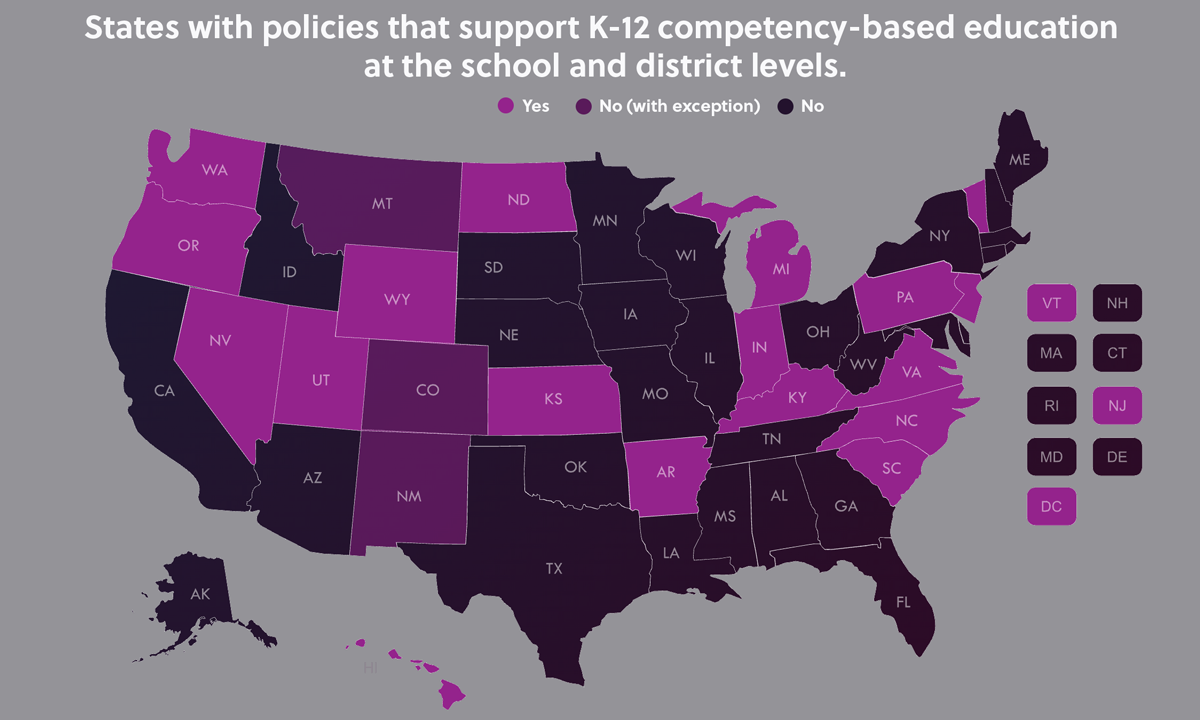New Interactive Map Showcases Personalized Learning in All 50 States
Hammonds & Hite: The adoption of policies to support competency-based teaching & learning marks a significant shift in how student success is viewed.

Get stories like this delivered straight to your inbox. Sign up for The 74 Newsletter
Across the United States, a transformative shift is underway in K-12 education — one that reimagines how and where learning occurs and what it means to prepare students for the future. Real-world learning is increasingly happening beyond the classroom, in settings such as local businesses, nonprofits or technical training centers. This movement is supported by the growing adoption of competency-based education, an approach that allows students to advance based on mastery of skills and knowledge rather than their age or time spent in class. In this approach, learning is personalized, relevant and based on a students’ experiences and aspirations.
All 50 states now have competency-based education policies, a striking contrast to just over a decade ago, when only about half of the states had such programs in place. This reflects a growing commitment to recognizing multiple pathways to success, such as industry credentials, dual enrollment and other accreditations beyond the traditional K-12 diploma.
In an increasingly competitive and ever-changing global economy, the traditional approach is clearly insufficient for the challenges ahead. Competency-based education responds to this challenge by ensuring that students master essential skills and acquire knowledge, rather than just memorizing facts. It equips learners with the durable and transferable skills they will need to thrive in a rapidly changing world. What’s more, people across the country are demanding a shift in what learning looks like. A recent survey found that 91% of students, educators and parents agreed that there was an opportunity post-pandemic to “reimagine public education to meet children’s academic, social and emotional needs and ensure that all children can thrive.”
The momentum behind competency-based education reflects this broad desire to fundamentally shift school culture, structure and instruction.
At Aurora and KnowledgeWorks, we have worked alongside state, district, school and classroom leaders who are dedicated to learner-centered education. To support this movement, our organizations have partnered to launch a new interactive map to showcase competency-based education in every state. The tool gives visitors a quick view of how each state approaches these policies and highlights deeper stories of innovation, including:
- Arkansas: Fifteen schools in seven school districts are implementing increased out-of-school learning opportunities and focusing on plans that move students ahead when they’ve shown they understand the skill or concept instead of having everyone moving on at the same pace.
- Kentucky: Students set goals and make daily decisions about their learning, progressing when they’re ready. Teachers act as coaches and help students develop skills for lifelong learning
- Nevada: Co-created its Portrait of a Learner framework in partnership with educators, students, community members and policymakers. The portrait reflects a shared vision for future-ready graduates and outlines the skills, knowledge and mindsets they will need by the time they graduate to succeed in college, career and life.
- Utah: Principals and educators worked together to ensure tools were in place that could be used to measure progress toward the 13 characteristics outlined in the Portrait of a Graduate framework. This helped both students and teachers, spanning preschool to postsecondary, understand the ultimate learning goals, track growth over time and identify what would be needed to reach the desired outcomes.
- Wisconsin: Schools like the High School of Health Sciences in Kettle Moraine are providing expanded opportunities and pathways and leveraging community partnerships with hospitals, veterinary clinics, fire stations and more to give students real-world experiences.
- Wyoming: A statewide pilot program that helps schools develop and implement instructional practices and assessments that are more responsive to students and aligned with the Profile of a Graduate framework.
For states that don’t have such programs, there’s no need to try implementing them alone. KnowledgeWorks, for example, offers a roadmap that state leaders can follow to effectively advance competency-based policies, including those that are captured in the new map. Its suggestions include:
- Establish a clear and shared purpose, starting with a statewide Portrait of a Learner or Graduate framework, to define the essential skills students will need for future success
- Develop policies that remove restrictive funding limits, rigid assessment requirements and credits awarded based on time spent in class that hinder local innovation
- Design assessment systems to track mastery and inform learning progression
- Identify indicators to measure impact, defining metrics that will be used to gauge success and drive continuous improvement
- Support educators and students by providing professional development, coaching and resources that will help teachers shift their practices to those that are more student-centered.
The education systems of the future will be characterized by student-centered learning that occurs both in school and in the community, guided by shared visions of what students should know and be able to do. The adoption of policies to support competency-based teaching and learning across all 50 states marks a significant shift in how education and success are viewed in this country. But long-term change will require ongoing collaboration among policymakers, educators and communities to develop the necessary infrastructure for this kind of transformation to take shape and sustain.
An education system that truly prepares every student for success is possible, but only through collective effort and a shared commitment to innovation.
Get stories like these delivered straight to your inbox. Sign up for The 74 Newsletter

;)
